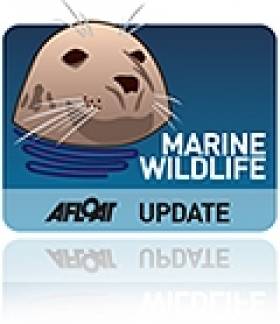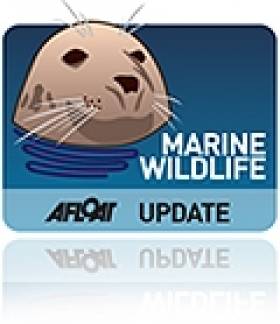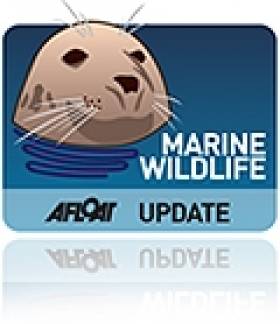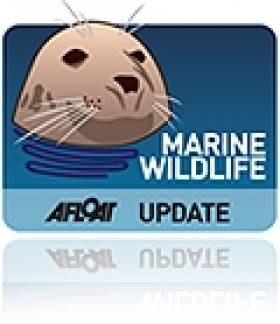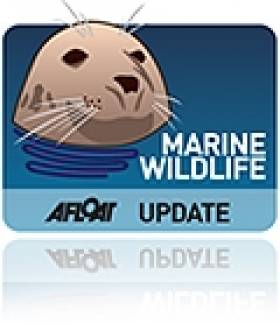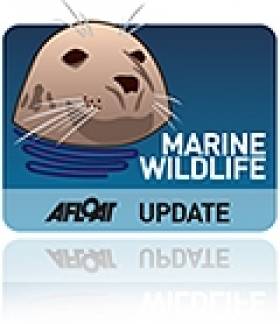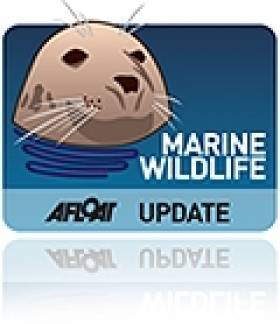Displaying items by tag: marine wildlife
Kerry TD Repeats Call For Seal Cull
#MarineWildlife - Kerry TD has reiterated his call for a seal cull in the West of Ireland to help preserve a fishing industry that's been badly affected by weeks of extreme weather.
According to TheJournal.ie, Deputy Michael Healy-Rae said a rise in seal numbers along the coast "is affecting fishermen's livelihoods" and that a cull in their numbers is "badly needed".
However, the ISPCA says there is "no evidence" that seals are having a detrimental effect on fish stocks off the west coast, adding their belief that the animals are being "scapegoat-ed".
TheJournal.ie has much more on the story HERE.
Young Porpoise In Distress In Lough Foyle
#MarineWildlife - The Irish Examiner reports on efforts to save an injured porpoise calf that was found beached on the shores of Lough Foyle yesterday (25 February).
Local people managed to help the young marine mammal, which has a wound on its tail fin, back into deeper water - but strong wind and wave action forced it into the stream of the Bredagh river.
It currently appears to be struggling in the mix of saltwater and freshwater, the latter of which can cause kidney and skin serious problems if cetaceans are exposed to it for extended periods.
The Irish Examiner has more on the story HERE.
Dingle's Seal Sanctuary Another Victim Of Violent Storms
#MarineWildlife - Baby seals injured in the recent severe weather have been rendered homeless after their sanctuary in Dingle was destroyed in last week's Storm Darwin.
As the Irish Independent reports, the Dingle Wildlife and Seal Sanctuary is dealing with what amounts to a double catastrophe, picking up the pieces of its storm-ravaged facilities while caring for unprecedented numbers of injured marine mammals.
"We have seals coming in who are essentially being thrown off rocks, so they have experienced severe trauma, with broken bones and bruises," said animal operation manager Ally McMillan - who added that among those that have survived, many require surgery, with four already in intensive care.
The Irish Independent has more on the story HERE.
#MarineWildlife - Inland Fisheries Ireland (IFI) funded the Coastal and Marine Research Centre (CMRC) and University College Cork, in conjunction with partners in UCC's School of Biology, Ecology and Environmental Science (BEES) and the Marine Institute to undertake a two-year pilot study to investigate seal predation on salmon stocks in the Moy and Slaney estuaries.
In the study, which began in August 2011 and continued to August 2013, salmonids were found in the diet of both grey and harbour seals using identification of salmonid bones recovered from the scat (faeces) of seals collected at seal haulout sites in the Moy and Slaney.
Salmonids were recovered in relatively low numbers, representing only 1.6% of the total prey numbers in the Slaney in Co Wexford and less than 5% in the Moy in Co Sligo. But due to the large size of individual salmonids, they comprised approximately 15% of the total prey biomass consumed.
The presence of salmonids in the diet of seals is likely to represent consumption of both salmon (Salmo salar) and sea trout (Salmo trutta), with contribution to the diet related to seasonal abundance.
Genetic techniques were employed to confirm salmonid species identification based on hard structures, with both salmon and sea trout DNA being detected in scats.
The removal of salmonids by seals, or other predators, must be placed into context of the amount removed by fisheries. In the Moy, 6,564 salmon were caught (non-release) by rod fisheries (five-year average, P Gargan IFI pers comm) which is likely to be far higher than that removed by seals in the area.
However, smaller salmon population units are most vulnerable to predation, and even low levels of predation by 'specialist' seals (or other predators) could have disproportionately large effects on small salmon population units such as in the Slaney.
The full report is available to download as a 4.3MB PDF file HERE.
Portaferry Aquarium 'Saved' Pending £900k Govt Grant
#MarineWildlife - Northern Ireland's Exploris aquarium will be saved - provided the local council receives a one-off capital grant from Stormont.
BBC News reports that a new business plan to preserve the Portaferry aquarium, which is one of the North's biggest tourist attractions, has been agreed.
But the plan's success is subject to funding of £900,000 (€1.09 million) from the NI Executive as part of a financial rescue package for the facility.
Ards Borough Council, which has run the Co Antrim aquarium since its opening in 1987, says it can no longer afford its annual operating costs of some £500,000 (€600,000).
And its closure could see more than 3,000 marine animals presently housed in the facility destroyed.
Should the new funding be confirmed, Ards Borough Council would keep Exploris open for this year's peak spring/summer period before closing for a six-month refurbishment in the autumn.
The business plan for Exploris would also preserve the aquarium's seal sanctuary, although its own future was confirmed by Environment Minister Mark Durkan in November.
BBC News has more on the story HERE.
Stranded Seal Rescued By Brothers Returns To Open Water
#MarineWildlife - The baby seal rescued by three brothers on the Dingle Peninsula three months ago has been released back into the sea, according to the Irish Independent.
Back in October, Afloat.ie related the rescue of the stranded seal pup by the O'Sullivan brothers Marwin, Leon and Rory while they were on a family break in Kerry over the October bank holiday weekend.
Named Lena by seven-year-old Rory, the seal was taken into the care of the Dingle Wildlife and Seal Sanctuary, who nursed her back to health after a serious bout of the flu among other ailments.
And now she's back swimming in the Altantic, while some 30 other seals - victims of the recent stormy weather - continue to receive TLC at the sanctuary.
The Irish Independent has more on the story HERE.
America's Dolphin Death Toll Show No Signs Of Abating
#MarineWildlife - The dolphin death toll on America's Atlantic coast caused by a measels-like virus now exceeds 1,000 - and marine scientists have warned the Guardian that the epidemic shows now signs of slowing down.
As reported in August on Afloat.ie, more than 300 deaths of bottlenose dolphins found between New York and North Carolina - more than 10 times the average for the time of year - were connected with the presence of morbillivirus.
Researchers speculate that the marine mammals have somehow lost their natural immunity to the disease, which first appeared in the late 1980s when it killed a known 740 cetaceans - but factors due to climate change have also not been ruled out.
The previous outbreak of morbillivirus wiped out half of all of the Eastern Seaboard's coastal migratory dolphins, whose population currently stands at more than 39,000 thanks to conservation efforts since that last epidemic.
It's not believed there is any connection between the morbillivirus resurgence on the far side of the Atlantic and the continued rise in dolphin strandings around Ireland.
However, the Irish Whale and Dolphin Group (IWDG) has identified a different threat to Irish cetaceans, calling for a ban on pelagic fishing within Special Areas of Conservation in West Cork and the Shannon Estuary in order to preserve a key food source for local dolphins and porpoise.
"The removal of herring and sprat could have a significant impact on [cetaceans'] foraging efficiency and hence on the life histories of harbour porpoise and bottlenose dolphins, especially their reproductive fitness," says the IWDG's Dr Simon Berrow.
Ancient Shark Species May Face Extinction In Irish Waters
#MarineWildlife - Fewer than a dozen of a once plentiful native shark species that dates back some four million years remain in Irish waters, as the Irish Examiner reports.
The bottom-feeding angel shark has fallen victim over the years to fishermen's nets used to catch turbot and crayfish - and now its numbers may be down to "the last dozen or so", according to Dingle Ocean World director Kevin Flannery.
The Irish Examiner has more on the story HERE.
New Species Confirmed At Rockall Deep Ocean Gas Vent
#MarineWildlife - Four new species of marine wildlife have been discovered off Rockall, as the Guardian reports.
It was a bonus Christmas present for marine scientists in Scotland who've announced that a handful of the array of deep ocean creatures found at the 'cold seep' methane gas vent in the North Atlantic - namely a large sea snail and two clams - have been confirmed as species new to science.
One of the clams, Thyasira scotiae, and the sea snail Volutopsius scotiae have been named after the research vessel MRV Scotia, while the clam Isorropodon mackayi is named in tribute to mollusc expert David Mackay. A marine worm also discovered is as yet unnamed pending examination.
As previously reported on Afloat.ie, the Rockall vent and its surrounds were discovered by scientists last year and since explored on a number of occasions - their findings prompting the International Convention on the Exploration of the Seas to recommend a ban on fishing in the area around the Rockall basin, 260 miles west of the Hebrides.
The new discoveries come in the same year as Irish researchers celebrate the discovery of an amazing new undersea world in the Whittard Canyon on the Irish Atlantic margin, containing larger than average molluscs that may be up to 200 years old.
'Fantastic Opportunity' To See Beached Fin Whale On Achill Island
#MarineWildlife - There's a "fantastic opportunity to witness the second largest animal on the planet close up" on Achill Island over the next few days after a male fin whale was stranded on Keel Beach on Christmas Eve.
The 20-metre-long marine giant live stranded on the beach but died some hours later, as the Irish Whale and Dolphin Group reports. It is as yet unknown what caused the fin whale to strand, but samples of skin, blubber, muscle and baleen have been taken for assessment.
TheJournal.ie repeats Achill Coast Guard's warning for anyone coming to see the whale to stay on the shore and not venture into the surf as the strongest storm in 15 years continues to sweep the country.


























